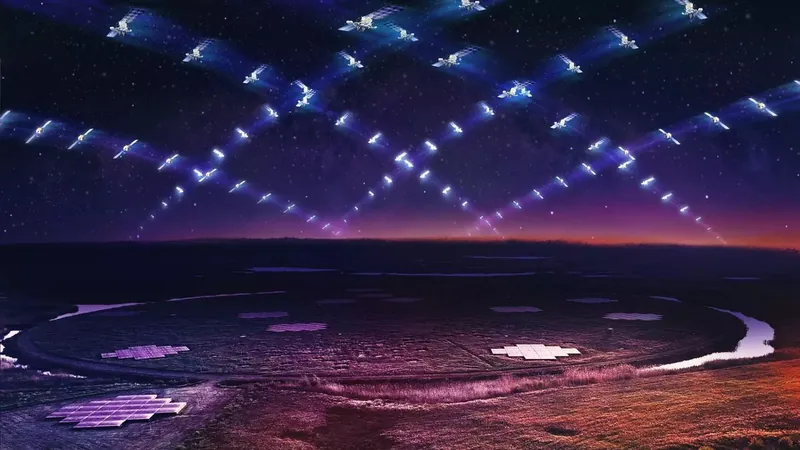
Is SpaceX's Starlink Disrupting Our View of the Universe? New Satellites Emit Alarming Levels of Radiation!
2024-09-27
The latest findings reveal that SpaceX's next-generation Starlink satellites are emitting significantly more radiation than earlier models, raising concerns among astronomers about potential disruptions to cosmic observations. This troubling trend suggests that we may be approaching an irreversible “inflection point,” jeopardizing our ability to study distant celestial bodies effectively.
In July 2023, a study exposed that the initial Starlink satellites, launched in 2019, were leaking unintended electromagnetic radiation (UEMR) into low Earth orbit. This radiation comprises radio waves emitted inadvertently while these satellites transmit signals back to Earth. Unfortunately, the frequencies emitted by these satellites bear a striking resemblance to the signals coming from profound cosmic phenomena, including stars, black holes, and pulsars—causing significant interference for radio astronomers.
SpaceX is in the process of replacing its Generation 1 satellites with advanced Generation 2 models, which made their debut in February 2023. These new spacecraft are reportedly smaller, more powerful, and capable of advanced maneuverability. However, a recent study published on September 18 in the journal *Astronomy and Astrophysics* has revealed an alarming truth: the new satellites leak even more radiation than their predecessors.
Using the vast Low-Frequency Array (LOFAR) telescope—an extensive network of radio antennas across Europe—researchers discovered that the Generation 2 “V2 mini” satellites are the worst offenders, potentially emitting up to 32 times more UEMR. This intensity is strikingly high; the radiation from these satellites is estimated to be up to 10 million times brighter than the faintest objects visible to radio telescopes.
As SpaceX ramps up its satellite launches—over 1,300 of the V2 minis were deployed in 2024 alone—this issue is expected to escalate. Other satellite megaconstellations, like China’s Thousand Sails and Amazon's Project Kuiper, are also emerging, which could exacerbate the problem if they experience similar radiation leaks. Some estimates suggest there could be as many as 100,000 satellites in orbit by the end of this decade, raising alarm bells among scientists who warn of potential blindness to our universe.
Dr. Federico Di Vruno, an astronomer at the SKA observatory in the UK, emphasized the urgency of the situation: “If we keep going down this path, we could reach a point where the UEMR from these satellites obscures our view completely.” He called for immediate action to protect our observational capabilities, ensuring that our skies remain a portal to the universe.
But the dangers of Starlink satellites do not stop at radiation. They also pose challenges for visual astronomers, often creating streaks of light in time-lapse photographs. Additionally, these satellites are vulnerable to solar storms, leading to increased risks of collisions in orbit—a situation exacerbated by their significant rise in numbers.
Moreover, when these satellites reach the end of their operational lifespan, they contribute to atmospheric metal pollution as they enter Earth’s atmosphere. This pollution could potentially interfere with our planet’s protective magnetic field, creating even more concern for scientists.
SpaceX's Falcon 9 rockets, responsible for deploying these satellites, have faced scrutiny as well. Numerous launches have been grounded due to explosive failures, and they are known to create "ionospheric holes" during their ascent and descent through the atmosphere, further complicating the overall situation.
As we stand on the brink of a potential astronomical crisis, the question remains: Are we sacrificing our understanding of the universe for a satellite internet revolution? The implications are profound and demand immediate attention from policymakers, scientists, and the public alike.



 Brasil (PT)
Brasil (PT)
 Canada (EN)
Canada (EN)
 Chile (ES)
Chile (ES)
 España (ES)
España (ES)
 France (FR)
France (FR)
 Hong Kong (EN)
Hong Kong (EN)
 Italia (IT)
Italia (IT)
 日本 (JA)
日本 (JA)
 Magyarország (HU)
Magyarország (HU)
 Norge (NO)
Norge (NO)
 Polska (PL)
Polska (PL)
 Schweiz (DE)
Schweiz (DE)
 Singapore (EN)
Singapore (EN)
 Sverige (SV)
Sverige (SV)
 Suomi (FI)
Suomi (FI)
 Türkiye (TR)
Türkiye (TR)